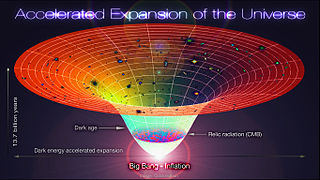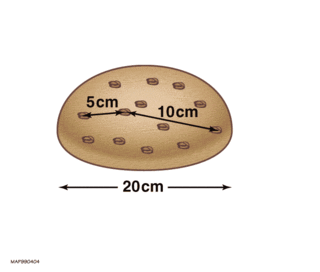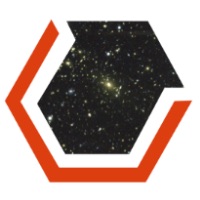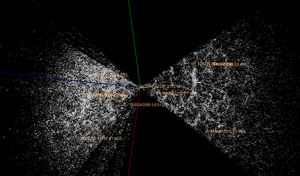
In physics, a redshift is an increase in the wavelength, and corresponding decrease in the frequency and photon energy, of electromagnetic radiation. The opposite change, a decrease in wavelength and simultaneous increase in frequency and energy, is known as a negative redshift, or blueshift. The terms derive from the colours red and blue which form the extremes of the visible light spectrum. The three main causes of electromagnetic redshift in astronomy and cosmology are, first, radiation traveling between objects that are moving apart ; second, the gravitational redshift due to radiation traveling towards an object in a weaker gravitational potential; and third, the cosmological redshift due to radiation traveling through expanding space. All sufficiently distant light sources show redshift for a velocity proportionate to their distance from Earth, a fact known as Hubble's law.

Observations show that the expansion of the universe is accelerating, such that the velocity at which a distant galaxy recedes from the observer is continuously increasing with time. The accelerated expansion of the universe was discovered during 1998 by two independent projects, the Supernova Cosmology Project and the High-Z Supernova Search Team, which both used distant type Ia supernovae to measure the acceleration. The idea was that as type Ia supernovae have almost the same intrinsic brightness, and since objects that are further away appear dimmer, we can use the observed brightness of these supernovae to measure the distance to them. The distance can then be compared to the supernovae's cosmological redshift, which measures how much the universe has expanded since the supernova occurred; the Hubble law established that the further an object is from us, the faster it is receding. The unexpected result was that objects in the universe are moving away from one another at an accelerated rate. Cosmologists at the time expected that recession velocity would always be decelerating, due to the gravitational attraction of the matter in the universe. Three members of these two groups have subsequently been awarded Nobel Prizes for their discovery. Confirmatory evidence has been found in baryon acoustic oscillations, and in analyses of the clustering of galaxies.

Hubble's law, also known as the Hubble–Lemaître law, is the observation in physical cosmology that galaxies are moving away from Earth at speeds proportional to their distance. In other words, the farther they are, the faster they are moving away from Earth. The velocity of the galaxies has been determined by their redshift, a shift of the light they emit toward the red end of the visible spectrum.

The Hubble Deep Field (HDF) is an image of a small region in the constellation Ursa Major, constructed from a series of observations by the Hubble Space Telescope. It covers an area about 2.6 arcminutes on a side, about one 24-millionth of the whole sky, which is equivalent in angular size to a tennis ball at a distance of 100 metres. The image was assembled from 342 separate exposures taken with the Space Telescope's Wide Field and Planetary Camera 2 over ten consecutive days between December 18 and 28, 1995.
The Sunyaev–Zeldovich effect is the spectral distortion of the cosmic microwave background (CMB) through inverse Compton scattering by high-energy electrons in galaxy clusters, in which the low-energy CMB photons receive an average energy boost during collision with the high-energy cluster electrons. Observed distortions of the cosmic microwave background spectrum are used to detect the disturbance of density in the universe. Using the Sunyaev–Zeldovich effect, dense clusters of galaxies have been observed.

The cosmic distance ladder is the succession of methods by which astronomers determine the distances to celestial objects. A direct distance measurement of an astronomical object is possible only for those objects that are "close enough" to Earth. The techniques for determining distances to more distant objects are all based on various measured correlations between methods that work at close distances and methods that work at larger distances. Several methods rely on a standard candle, which is an astronomical object that has a known luminosity.
Observational cosmology is the study of the structure, the evolution and the origin of the universe through observation, using instruments such as telescopes and cosmic ray detectors.
The Sloan Digital Sky Survey or SDSS is a major multi-spectral imaging and spectroscopic redshift survey using a dedicated 2.5-m wide-angle optical telescope at Apache Point Observatory in New Mexico, United States. The project began in 2000 and was named after the Alfred P. Sloan Foundation, which contributed significant funding.
The ΛCDM or Lambda-CDM model is a parameterization of the Big Bang cosmological model in which the universe contains three major components: first, a cosmological constant denoted by Lambda associated with dark energy; second, the postulated cold dark matter ; and third, ordinary matter. It is frequently referred to as the standard modelof Big Bang cosmology because it is the simplest model that provides a reasonably good account of the following properties of the cosmos:

In astronomy, the 2dF Galaxy Redshift Survey, 2dF or 2dFGRS is a redshift survey conducted by the Australian Astronomical Observatory (AAO) with the 3.9m Anglo-Australian Telescope between 1997 and 11 April 2002. The data from this survey were made public on 30 June 2003. The survey determined the large-scale structure in two large slices of the Universe to a depth of around 2.5 billion light years. It was the world's largest redshift survey between 1998 and 2003. Matthew Colless, Richard Ellis, Steve Maddox and John Peacock were in charge of the project. Team members Shaun Cole and John Peacock were awarded a share of the 2014 Shaw Prize in astronomy for results from the 2dFGRS.
Redshift quantization, also referred to as redshift periodicity, redshift discretization, preferred redshifts and redshift-magnitude bands, is the hypothesis that the redshifts of cosmologically distant objects tend to cluster around multiples of some particular value. In standard inflationary cosmological models, the redshift of cosmological bodies is ascribed to the expansion of the universe, with greater redshift indicating greater cosmic distance from the Earth. This is referred to as cosmological redshift. Ruling out errors in measurement or analysis, quantized redshift of cosmological objects would either indicate that they are physically arranged in a quantized pattern around the Earth, or that there is an unknown mechanism for redshift unrelated to cosmic expansion, referred to as "intrinsic redshift" or "non-cosmological redshift".

APM 08279+5255 is a very distant, broad absorption line quasar located in the constellation Lynx. It is magnified and split into multiple images by the gravitational lensing effect of a foreground galaxy through which its light passes. It appears to be a giant elliptical galaxy with a supermassive black hole and associated accretion disk. It possesses large regions of hot dust and molecular gas, as well as regions with starburst activity.

The Dark Energy Survey (DES) is an astronomical survey designed to constrain the properties of dark energy. It uses images taken in the near-ultraviolet, visible, and near-infrared to measure the expansion of the universe using Type Ia supernovae, baryon acoustic oscillations, the number of galaxy clusters, and weak gravitational lensing. The collaboration is composed of research institutions and universities from the United States, Australia, Brazil, the United Kingdom, Germany, Spain, and Switzerland. The collaboration is divided into several scientific working groups. The director of DES is Josh Frieman.
In cosmology, baryon acoustic oscillations (BAO) are fluctuations in the density of the visible baryonic matter of the universe, caused by acoustic density waves in the primordial plasma of the early universe. In the same way that supernovae provide a "standard candle" for astronomical observations, BAO matter clustering provides a "standard ruler" for length scale in cosmology. The length of this standard ruler is given by the maximum distance the acoustic waves could travel in the primordial plasma before the plasma cooled to the point where it became neutral atoms, which stopped the expansion of the plasma density waves, "freezing" them into place. The length of this standard ruler can be measured by looking at the large scale structure of matter using astronomical surveys. BAO measurements help cosmologists understand more about the nature of dark energy by constraining cosmological parameters.

UDFy-38135539 is the Hubble Ultra Deep Field (UDF) identifier for a galaxy which was calculated as of October 2010 to have a light travel time of 13.1 billion years with a present proper distance of around 30 billion light-years.

Cosmic voids are vast spaces between filaments, which contain very few or no galaxies. The cosmological evolution of the void regions differs drastically from the evolution of the Universe as a whole: there is a long stage when the curvature term dominates, which prevents the formation of galaxy clusters and massive galaxies. Hence, although even the emptiest regions of voids contain more than ~15% of the average matter density of the Universe, the voids look almost empty to an observer. Voids typically have a diameter of 10 to 100 megaparsecs ; particularly large voids, defined by the absence of rich superclusters, are sometimes called supervoids. They were first discovered in 1978 in a pioneering study by Stephen Gregory and Laird A. Thompson at the Kitt Peak National Observatory.
Idit Zehavi is an Israeli astrophysicist and researcher who discovered an anomaly in the mapping of the cosmos, which offered insight into how the universe is expanding. She is part of the team completing the Sloan Digital Sky Survey and is one of the world's most highly cited scientists according to the list published annually by Thomson Reuters.

The Dark Energy Spectroscopic Instrument (DESI) is a scientific research instrument for conducting spectrographic astronomical surveys of distant galaxies. Its main components are a focal plane containing 5,000 fiber-positioning robots, and a bank of spectrographs which are fed by the fibers. The new instrument will enable an experiment to probe the expansion history of the universe and the mysterious physics of dark energy.

The WiggleZ Dark Energy Survey was a large-scale astronomical redshift survey carried out on the 3.9 metre Anglo-Australian Telescope (AAT) at the Siding Spring Observatory, New South Wales between August 2006 and January 2011. The name stems from the measurement of baryon acoustic oscillations in the distribution of galaxies.












